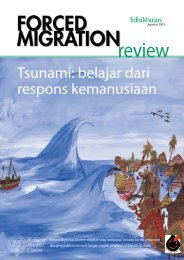FMR 42 full issue pdf - Forced Migration Review
FMR 42 full issue pdf - Forced Migration Review
FMR 42 full issue pdf - Forced Migration Review
Create successful ePaper yourself
Turn your PDF publications into a flip-book with our unique Google optimized e-Paper software.
<strong>FMR</strong> <strong>42</strong><br />
Sexual orientation and gender identity and the protection of forced migrants 49<br />
nature of immigration detention – exacerbate<br />
mental illness. Voyeuristic or offensive<br />
questioning of LGBTI migrants by migration<br />
authorities also detrimentally affects their<br />
mental health. Since access to mental health<br />
counselling in migrant detention is extremely<br />
rare, sexual minorities not only suffer<br />
ongoing after-effects of harm experienced<br />
in countries of asylum but also are often retraumatised<br />
by experiences in detention.<br />
Rights of migrants in detention<br />
While LGBTI detainees – particularly those<br />
who are transgender – are often so visible<br />
in immigration detention systems that they<br />
are put at grave physical risk, they remain<br />
invisible where their protection concerns<br />
matter most: in the policies and guidelines<br />
that are designed to protect all detainees<br />
from harm and process migrants equitably<br />
and with dignity under international law.<br />
The core elements of protection in human<br />
rights law that relate to detainees include<br />
the prohibition on torture, the prohibition<br />
on arbitrary detention, limits on detention<br />
time, non-discrimination clauses, and the<br />
right to liberty. Both the UN Human Rights<br />
Committee and the UN General Assembly have<br />
confirmed that these tenets of human rights<br />
law must be applied without discrimination<br />
to all peoples, including migrants. Other<br />
refugee-specific legal standards promulgated<br />
by UNHCR prohibit penalising migrants<br />
for illegal entry or presence, and assert<br />
that detention of asylum seekers should<br />
only be contemplated as a last resort.<br />
In October 2012, UNHCR <strong>issue</strong>d new<br />
guidelines governing the detention of refugees.<br />
Intended as guidance to governments, legal<br />
practitioners, decision-makers and others,<br />
they provide valuable leadership on the<br />
special concerns of LGBTI asylum seekers<br />
in detention. Guideline 9.7 states that:<br />
Measures may need to be taken to ensure that any<br />
placement in detention of lesbian, gay, bisexual,<br />
transgender or intersex asylum-seekers avoids<br />
exposing them to risk of violence, ill-treatment or<br />
physical, mental or sexual abuse; that they have<br />
access to appropriate medical care and counselling,<br />
where applicable; and that detention personnel<br />
and all other officials in the public and private<br />
sector who are engaged in detention facilities are<br />
trained and qualified, regarding international<br />
human rights standards and principles of equality<br />
and non-discrimination, including in relation to<br />
sexual orientation or gender identity. Where their<br />
security cannot be assured in detention, release<br />
or referral to alternatives to detention would<br />
need to be considered. In this regard, solitary<br />
confinement is not an appropriate way to manage<br />
or ensure the protection of such individuals. 2<br />
Although extremely welcome, UNHCR’s new<br />
Detention Guidelines alone are insufficient to<br />
address the severe problems that characterise<br />
the detention of sexual minority migrants.<br />
Ultimately, states must provide alternatives<br />
to detention for all self-identifying sexual<br />
minorities – establishing non-custodial<br />
measures and alternative sentencing<br />
procedures. 3 In addition, migrant detention<br />
facility staff and management must be trained<br />
on and sensitised to the protection needs<br />
of LGBTI migrants. Access to appropriate<br />
health-care, welfare and contact with the<br />
outside world – including legal counsel,<br />
medical attention and external LGBTI support<br />
systems – must be ensured. LGBTI detainee<br />
safety and the ending of discrimination and<br />
abuse, both by other detainees and by prison<br />
officials, must be the highest priority.<br />
Shana Tabak shanatabak@gmail.com is a<br />
Practitioner-in-Residence at American University’s<br />
International Human Rights Law Clinic. Rachel<br />
Levitan rslevitan@gmail.com is Senior Counsel<br />
(Refugees and <strong>Migration</strong>) at HIAS www.hias.org<br />
An expanded report of this research is to be<br />
published as an article in Volume 37 of the<br />
Harvard Journal of Law and Gender.<br />
1. Assigned male at birth but with female gender identity.<br />
2. Detention Guidelines: Guidelines on the Applicable Criteria<br />
and Standards relating to the Detention of Asylum-Seekers and<br />
Alternatives to Detention, 2012<br />
www.unhcr.org/refworld/docid/503489533b8.html<br />
3. <strong>FMR</strong> 44 (forthcoming September 2013) will include a major feature<br />
on detention, including alternatives to detention<br />
www.fmreview.org/detention




